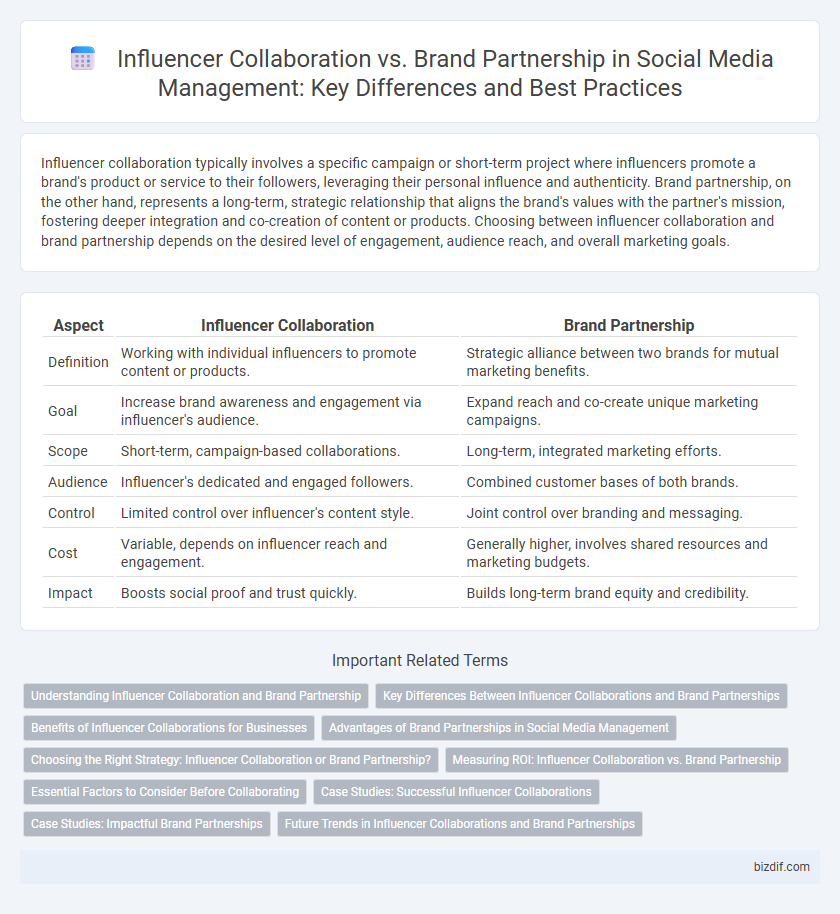Influencer collaboration typically involves a specific campaign or short-term project where influencers promote a brand's product or service to their followers, leveraging their personal influence and authenticity. Brand partnership, on the other hand, represents a long-term, strategic relationship that aligns the brand's values with the partner's mission, fostering deeper integration and co-creation of content or products. Choosing between influencer collaboration and brand partnership depends on the desired level of engagement, audience reach, and overall marketing goals.
Table of Comparison
| Aspect | Influencer Collaboration | Brand Partnership |
|---|---|---|
| Definition | Working with individual influencers to promote content or products. | Strategic alliance between two brands for mutual marketing benefits. |
| Goal | Increase brand awareness and engagement via influencer's audience. | Expand reach and co-create unique marketing campaigns. |
| Scope | Short-term, campaign-based collaborations. | Long-term, integrated marketing efforts. |
| Audience | Influencer's dedicated and engaged followers. | Combined customer bases of both brands. |
| Control | Limited control over influencer's content style. | Joint control over branding and messaging. |
| Cost | Variable, depends on influencer reach and engagement. | Generally higher, involves shared resources and marketing budgets. |
| Impact | Boosts social proof and trust quickly. | Builds long-term brand equity and credibility. |
Understanding Influencer Collaboration and Brand Partnership
Influencer collaboration involves working with individual influencers to promote a brand's products or services through authentic, personalized content that leverages the influencer's loyal audience. Brand partnership refers to a longer-term, strategic alliance where the brand and influencer co-create campaigns, share shared goals, and often involve co-branded products or events to maximize mutual growth. Understanding the differences between these approaches helps marketers optimize engagement, brand awareness, and conversion rates by choosing the right type of collaboration based on campaign objectives.
Key Differences Between Influencer Collaborations and Brand Partnerships
Influencer collaborations typically involve short-term campaigns where influencers promote a product or service in exchange for payment or free products, emphasizing authentic content creation and audience engagement. Brand partnerships, by contrast, are long-term, strategic alliances focused on co-creating value, integrating brand messaging across multiple platforms, and driving sustained brand loyalty. The key differences lie in the duration, depth of collaboration, and shared marketing objectives between influencers and brands.
Benefits of Influencer Collaborations for Businesses
Influencer collaborations offer businesses targeted audience engagement by leveraging influencers' authentic connections and niche followings, resulting in higher trust and improved brand credibility. These partnerships drive increased brand awareness and generate valuable user-generated content, which enhances social proof and influences purchasing decisions. Collaborating with influencers also provides cost-effective marketing opportunities with measurable ROI through tracking engagement metrics and conversion rates.
Advantages of Brand Partnerships in Social Media Management
Brand partnerships in social media management offer long-term strategic advantages by building sustained brand credibility and fostering deeper audience trust. These collaborations often result in consistent content alignment and mutual growth, enabling more effective targeting and higher engagement rates. Leveraging established brand equity through partnerships increases visibility and drives stronger conversions compared to one-off influencer campaigns.
Choosing the Right Strategy: Influencer Collaboration or Brand Partnership?
Selecting the optimal strategy between influencer collaboration and brand partnership depends on campaign goals and target audience engagement. Influencer collaborations offer authentic content creation and immediate social proof through trusted individuals, while brand partnerships provide long-term alignment, co-branded initiatives, and extended market reach. Analyzing metrics such as audience demographics, engagement rates, and brand affinity ensures a tailored approach that maximizes ROI in social media management.
Measuring ROI: Influencer Collaboration vs. Brand Partnership
Measuring ROI in influencer collaboration relies heavily on tracking engagement metrics such as likes, shares, and comments, alongside conversion rates directly linked to unique promo codes or affiliate links. Brand partnerships, however, demand a broader analysis including long-term brand awareness growth, customer loyalty metrics, and overall sales impact influenced by co-branded campaigns. Both approaches benefit from leveraging analytics tools like Google Analytics, social media insights, and customer surveys to accurately assess the effectiveness of the investment.
Essential Factors to Consider Before Collaborating
Evaluating influencer collaboration versus brand partnership requires analyzing audience alignment, engagement rates, and content authenticity to ensure maximum campaign impact. Consider budget constraints, campaign objectives, and control over creative direction when choosing between individual influencers and established brand partnerships. Transparency in contract terms and clear performance metrics are essential to measure ROI and maintain long-term relationship value.
Case Studies: Successful Influencer Collaborations
Case studies reveal that successful influencer collaborations significantly boost brand visibility and engagement rates by leveraging the influencer's authentic connection with their audience. Brands such as Glossier and Daniel Wellington have demonstrated exponential growth through influencer partnerships that prioritize genuine content creation over traditional advertising. Metrics from these campaigns show increased follower growth, higher conversion rates, and improved return on investment compared to standard brand partnerships.
Case Studies: Impactful Brand Partnerships
Case studies reveal that impactful brand partnerships with influencers drive higher engagement and conversion rates compared to traditional influencer collaborations. Brands like Nike and Adidas demonstrate how long-term partnerships lead to authentic content creation and increased brand loyalty. Data shows these strategic alliances improve ROI by leveraging influencers' credibility and audience alignment effectively.
Future Trends in Influencer Collaborations and Brand Partnerships
Future trends in influencer collaborations and brand partnerships emphasize authentic storytelling, with micro and nano influencers gaining prominence for their higher engagement and trust rates. Advanced AI analytics and data-driven strategies enable brands to identify precise audience segments, optimizing campaign effectiveness. Video content, particularly short-form formats like Reels and TikTok, continues to dominate, driving more dynamic and interactive partnerships.
Influencer collaboration vs Brand partnership Infographic

 bizdif.com
bizdif.com